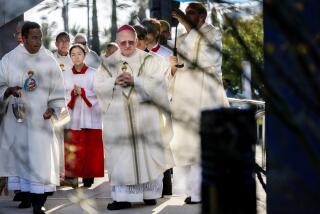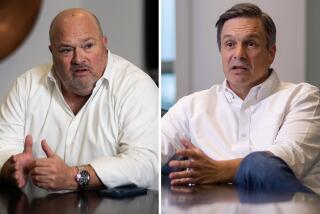A Ban on Kneeling? Some Catholics Won’t Stand for It
- Share via
At a small Catholic church in Huntington Beach, the pressing moral question comes to this: Does kneeling at the wrong time during worship make you a sinner?
Kneeling “is clearly rebellion, grave disobedience and mortal sin,” Father Martin Tran, pastor at St. Mary’s by the Sea, told his flock in a recent church bulletin. The Diocese of Orange backs Tran’s anti-kneeling edict.
Though told by the pastor and the archdiocese to stand during certain parts of the liturgy, a third of the congregation still gets on its knees every Sunday.
“Kneeling is an act of adoration,” said Judith M. Clark, 68, one of at least 55 parishioners who have received letters from church leaders urging them to get off their knees or quit St. Mary’s and the Diocese of Orange. “You almost automatically kneel because you’re so used to it. Now the priest says we should stand, but we all just ignore him.”
The debate is being played out in at least a dozen parishes nationwide.
Since at least the 7th century, Catholics have been kneeling after the Agnus Dei, the point during Mass when the priest holds up the chalice and consecrated bread and says, “Behold the lamb of God.” But four years ago, the Vatican revised its instructions, allowing bishops to decide at some points in the Mass whether their flocks should get on their knees. “The faithful kneel ... unless the Diocesan Bishop determines otherwise,” says Rome’s book of instructions. Since then, some churches have been built without kneelers.
The debate is part of the argument among Catholics between tradition and change. Traditionalists see it as the ultimate posture of submission to and adoration of God; modernists view kneeling as the vestige of a feudal past they would like to leave behind.
At the center of the controversy is the church’s concept of Christ, said Jesuit Father Lawrence J. Madden, director of the Georgetown Center for Liturgy at Georgetown University in Washington. It’s a question raised in the bestselling book “The Da Vinci Code.”
Because the earliest Christians viewed Jesus as God and man, Madden said, they generally stood during worship services to show reverence and equality. About the 7th century, however, Catholic theologians put more emphasis on Christ’s divinity and introduced kneeling as the only appropriate posture at points in the Mass when God was believed to be present.
Things started to change in the 1960s, Madden said, when Vatican II began moving the church back to its earliest roots. What has ensued, he said, is the predictable struggle of an institution revising centuries of religious practices.
The argument over kneeling, Madden said, is “a signal of the division in the church between two camps: those who have caught the spirit of Vatican II, and those who are a bit suspicious. Because it’s so visible, what happens at the Sunday worship event is a lightning rod for lots of issues.”
One flashpoint involves the Agnus Dei. Traditionalists say the faithful must then fall to their knees in awe for several minutes, believing that the bread and wine are literally the body and blood of Christ.
Lesa Truxaw, the Orange Diocese director of worship, said Bishop Tod D. Brown banned kneeling because standing “reflects our human dignity. It’s not that we think we’re equal to God, but we recognize that we are made in the image and likeness of God.”
Orange County parishioners are still allowed to kneel at other points in the Mass, including the Eucharistic prayers. Kneeling is optional as worshippers receive communion.
No less an authority than the pope is on record as favoring kneeling. Joseph Cardinal Ratzinger, who became Pope Benedict XVI last year, wrote in “The Spirit of the Liturgy,” published in 2000, that the gesture, “comes from the Bible and the knowledge of God.” He has not addressed the issue as pope.
American Catholic bishops have taken the opposite position. “Standing can be just as much an expression of respect for the coming of Christ,” said Msgr. Anthony F. Sherman, a spokesman for the liturgy secretariat of the U.S. Bishops Committee on the Liturgy based in Washington.
That hasn’t quieted critics.
“It’s hard to understand why any bishop would prohibit his people from expressing reverence in the way they have done for centuries,” said Helen Hull Hitchcock, a founder of the conservative Adoremus Society for the Renewal of Sacred Liturgy in St. Louis.
The controversy at St. Mary’s by the Sea began to intensify late last year after Brown appointed Tran to lead the 1,500-family parish.
Tran took over following the retirement of the church’s longtime pastor, who had offered a popular traditional Latin Mass.
Tran’s Mass reverted to the more modern English form practiced in most American churches, and hundreds of parishioners signed a petition in protest. Then, to pull the church into the modern era, the priest told members, they were not to kneel after the Agnus Dei.
Many refused to comply. “Not kneeling would be sinful,” said Manuel Ruiz, 45, “because that is what I believe I should do.”
Mary Tripoli, 54, a former member of the parish council, was dismissed for her insistence on kneeling: “Standing may be reverence, but kneeling is adoration. It’s the one thing that means Catholicism throughout the world. It’s what sets us apart.”
At least two altar boys, the parish altar servers coordinator and three members of the parish council have been dismissed from their duties for kneeling at the wrong time, according to parishioners.
Angered by the anti-kneeling edict, a group calling itself Save Saint Mary’s began distributing leaflets calling for its return outside church each Sunday.
Tran responded in the church bulletin with a series of strident weekly statements condemning what he called “despising the authority of the local bishop” by refusing his orders to stand, and calling the disobedience a mortal sin, considered the worst kind of offense, usually reserved for acts such as murder.
Tran sent letters to 55 kneeling parishioners “inviting” them to leave the parish and the diocese for, among other things, “creating misleading confusion, division and chaos in the parish by intentional disobedience and opposition to the current liturgical norms.”
Father Joe Fenton, spokesman for the Diocese of Orange, said the diocese supports Tran’s view that disobeying the anti-kneeling edict is a mortal sin. “That’s Father Tran’s interpretation, and he’s the pastor,” he said. “We stand behind Father Tran.”
Recipients of Tran’s banishment letter said they have declined his “invitation” to depart.
Kneeling, said Teri Carpentier, 50, is praying “with our bodies, not just our minds.”
During a recent Saturday afternoon Mass, dozens of worshippers defiantly knelt after the Agnus Dei.
One who didn’t was Winifred Mentzer, 84.
“I’ve been standing lately,” she later said, “because I’m all the way up front, and I know that the priest is watching. But I’m kneeling in my heart.”
More to Read
Sign up for Essential California
The most important California stories and recommendations in your inbox every morning.
You may occasionally receive promotional content from the Los Angeles Times.










